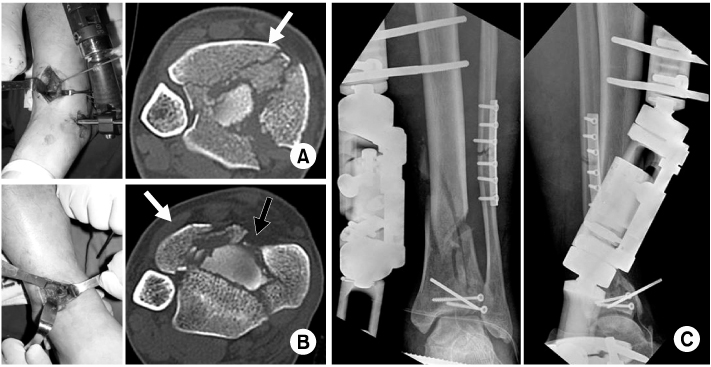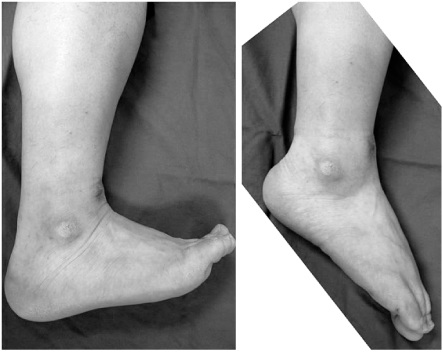J Korean Fract Soc.
2012 Jul;25(3):177-184.
The Results of Two Stage Surgical Treatment of Pilon Fractures
- Affiliations
-
- 1Department of Orthopedic Surgery, School of Medicine, Chosun University, Gwangju, Korea. leejy88@chosun.ac.kr
Abstract
- PURPOSE
To report the good results of two-stage treatment in pilon fractures.
MATERIALS AND METHODS
A retrospective study of 23 patients among 30 patients with pilon fractures from March 2006 to November 2008, who underwent two-stage treatment of pilon fractures with a minimum of 24 months follow-up. The mean follow-up period was 28 months (24~41 months). In the first stage of the operation, open reduction of the articular surface and external fixation were performed after minimal incision. As the soft tissue healed, locking compression plate fixation was performed with the Minimally invasive plate osteosynthesis. Radiographic evaluation was graded by the criteria of Burwell and Charnley, and functional assessment of the ankle was evaluated by the American Orthopaedic Foot and Ankle Society (AOFAS) ankle-hindfoot score.
RESULTS
The fractures were united within 16 weeks (12~30 weeks). The radiologic results showed anatomical reduction in 18 cases and a mean AOFAS score of 81. The mean range of ankle motion was 44 degrees. There were four complications: 1 case of wound infection and 3 cases of ankle osteoarthritis.
CONCLUSION
Two-stage treatment of pilon fractures is a good treatment method because it is designed to obtain early anatomical reduction, definitive stable fixation, low rates of soft tissue complication, and good range of ankle motion.
Keyword
Figure
Reference
-
1. Baumgaertel F, Buhl M, Rahn BA. Fracture healing in biological plate osteosynthesis. Injury. 1998. 29:Suppl 3. C3–C6.
Article2. Blauth M, Bastian L, Krettek C, Knop C, Evans S. Surgical options for the treatment of severe tibial pilon fractures: a study of three techniques. J Orthop Trauma. 2001. 15:153–160.
Article3. Bone LB. Fractures of the tibial plafond. The pilon fracture. Orthop Clin North Am. 1987. 18:95–104.
Article4. Bone L, Stegemann P, McNamara K, Seibel R. External fixation of severely comminuted and open tibial pilon fractures. Clin Orthop Relat Res. 1993. (292):101–107.
Article5. Borens O, Kloen P, Richmond J, Roederer G, Levine DS, Helfet DL. Minimally invasive treatment of pilon fractures with a low profile plate: preliminary results in 17 cases. Arch Orthop Trauma Surg. 2009. 129:649–659.
Article6. Bourne RB. Pylon fractures of the distal tibia. Clin Orthop Relat Res. 1989. (240):42–46.
Article7. Burwell HN, Charnley AD. The treatment of displaced fractures at the ankle by rigid internal fixation and early joint movement. J Bone Joint Surg Br. 1965. 47:634–660.
Article8. Coonrad RW. Fracture-dislocations of the ankle joint with impaction injury of the lateral weight-bearing surface of the tibia. J Bone Joint Surg Am. 1970. 52:1337–1344.
Article9. Destot E. Traumatismes du pied et rayons: X. Malleles, astragale, calcaneum, avant-pied. 1911. Paris: Masson;1–10.10. Mast JW, Spiegel PG, Pappas JN. Fractures of the tibial pilon. Clin Orthop Relat Res. 1988. (230):68–82.11. Mast JW, Teipner WA. A reproducible approach to the internal fixation of adult ankle fractures: rationale, technique, and early results. Orthop Clin North Am. 1980. 11:661–679.
Article12. Ovadia DN, Beals RK. Fractures of the tibial plafond. J Bone Joint Surg Am. 1986. 68:543–551.
Article13. Patterson MJ, Cole JD. Two-staged delayed open reduction and internal fixation of severe pilon fractures. J Orthop Trauma. 1999. 13:85–91.14. Pierce RO Jr, Heinrich JH. Comminuted intra-articular fractures of the distal tibia. J Trauma. 1979. 19:828–832.15. Rommens PM, Claes P, De Boodt P, Stappaerts KH, Broos PL. Therapeutic procedure and long-term results in tibial pilon fracture in relation to primary soft tissue damage. Unfallchirurg. 1994. 97:39–46.
Article16. Rüedi TP, Allgöwer M. The operative treatment of intra-articular fractures of the lower end of the tibia. Clin Orthop Relat Res. 1979. (138):105–110.
Article17. Shin HK, Choi JY, Lee JW. Treatment of the pilon fracture involving tibial shaft using two staged MIPO technique. J Korean Foot Ankle Soc. 2006. 10:184–189.18. Takakura Y, Tanaka Y, Kumai T, Tamai S. Low tibial osteotomy for osteoarthritis of the ankle. Results of a new operation in 18 patients. J Bone Joint Surg Br. 1995. 77:50–54.19. Teeny SM, Wiss DA. Open reduction and internal fixation of tibial plafond fractures. Variables contributing to poor results and complications. Clin Orthop Relat Res. 1993. (292):108–117.20. Tscherne H, Gotzen L. Tscherne H, Gotzen L, editors. External articular transfixation of joint injuries with severe soft tissue damage. Fractures with soft tissue injuries. 1984. Berlin: Springer-Verlag;103–117.
- Full Text Links
- Actions
-
Cited
- CITED
-
- Close
- Share
- Similar articles
-
- Clinical Evaluation for the Tibial Pilon Fractures
- Treatment of The Pilon Fracture involving Tibial Shaft using Two Staged MIPO Technique
- Minimal Surgical Treatment of the Tibial Pilon Fracture
- Treatment of Tibial Pilon Fractures: Ilizarov Method vs Conventional Methods
- Surgical Treatment of the Pilon Fractures






